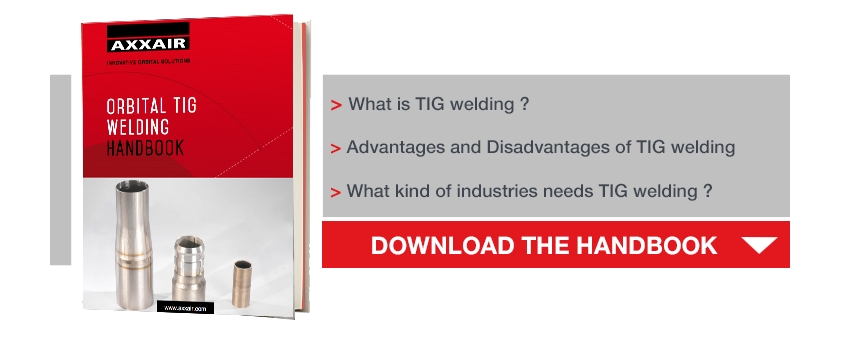TIG, WIG or GTAW? These three terminologies relate to the same process: TIG (Tungsten Inert Gas) welding. The only difference is the language. In German language, you translate Tungsten with Wolfram: Wolfram Inert Gas (WIG). In the United States, they call it Gas Tungsten Arc Welding (GTAW).TIG welding was developed in the forties. At the beginning, this process was used to weld corrosion resistant alloys. Welding these kinds of metals, especially aluminium and magnesium based alloys, was very difficult in the past. The TIG welding process has been developed at a high rate and allows a weld without oxidation of all metal grades available on the market.
How does orbital TIG welding work?
TIG welding is an arc welding process using a non-fusing electrode. An electric arc is created between a non-fusing electrode and the piece to be welded.
If a filler material is needed, it would be placed manually in the weld bead (welding rod) or in an automated way (filler wire spool).When we talk about Tungsten Inert Gas, Tungsten refers to the electrode and Inert Gas is the type of plasmagenic gas that will be used. The arc is created between the refractory electrode (- of the power source) and the weld piece (+ of the power source) in a gas stream. Generally speaking, welders use either one gas or a mix of several rare gases. The arc is created through the gas that circulates in the gas nozzle placed all around the electrode. Welding can be performed by a direct polarity (the – pole of the power source is connected to the electrode), for most of the metals and alloys - (steel, stainless steel, copper, titanium, nickel …), but not in the case of light aluminum alloys or magnesium. In these cases you will need to weld with alternating polarity (for a limited time the electrode is connected with the + pole of the power source). If you weld in a continuous way with alternating polarity (+ pole connected to the power source), the electrode will be damaged as it will melt.
Download our orbital TIG welding handbook for all information
Temperatures higher than 4800°C
The temperature of the welding cone where the electrode is located is higher than 4800°C. Due to these levels of temperatures, the equipment must be cooled either during prefabrication, or when using open welding heads, or directly in the welding head when you use closed chamber welding heads.The TIG welding process allows easy transfer from the electricity (the electric arc between the electrode and the weld piece) into heat, without any contact with the welding piece. These high temperatures create the fusion of the tube, allowing them to be joined together in this way. When using filler metal, the wire is directly added to the weld puddle under the electrode. TIG welding is a very stable process and can be used in all positions. Automating the process can be achieved very easily.
Our orbital TIG welding handbook will give you more information about this process that enables to achieve high quality welds. You can download it here!



